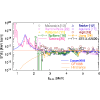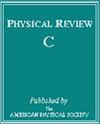Coincident measurement of the C12+C12 fusion cross section via the differential thick-target technique
IF 3.4
2区 物理与天体物理
Q1 Physics and Astronomy
引用次数: 0
Abstract
The fusion reaction is critical for the understanding and interpretation of the late phases of stellar evolution as well as the ignition and nucleosynthesis in cataclysmic binary systems such as type Ia thermonuclear supernovas and x-ray superbursts. Direct measurement of this reaction has been performed at the University of Notre Dame using particle- coincidence and differential thick-target techniques with SAND (a silicon detector array) at the high-intensity 5U Pelletron accelerator. Partial cross section results for the channels of to and at center-of-mass energies of 2.65–5 MeV that are relevant to nuclear astrophysics are reported. The total factor is constructed by taking into account contributions from the missing channels. The recommended reaction rate and its impact on the carbon burning process under astrophysical scenarios will be discussed.

通过差分厚目标技术同时测量 C12+C12 聚变截面
C12+C12 核聚变反应对于理解和解释恒星演化的晚期阶段以及 Ia 型热核超新星和 X 射线超级爆发等大灾变双星系统的点火和核合成至关重要。圣母大学在高强度 5U Pelletron 加速器上使用 SAND(硅探测器阵列),利用粒子-γ 重合和差分厚目标技术对这一反应进行了直接测量。报告了与核天体物理学有关的 2.65-5 MeV 质量中心能量下 p1 至 p10 和 α1 信道的部分截面结果。总 S*(E)因子是通过考虑缺失通道的贡献而构建的。将讨论推荐的反应速率及其对天体物理情景下碳燃烧过程的影响。
本文章由计算机程序翻译,如有差异,请以英文原文为准。
求助全文
约1分钟内获得全文
求助全文
来源期刊

Physical Review C
物理-物理:核物理
CiteScore
5.70
自引率
35.50%
发文量
0
审稿时长
1-2 weeks
期刊介绍:
Physical Review C (PRC) is a leading journal in theoretical and experimental nuclear physics, publishing more than two-thirds of the research literature in the field.
PRC covers experimental and theoretical results in all aspects of nuclear physics, including:
Nucleon-nucleon interaction, few-body systems
Nuclear structure
Nuclear reactions
Relativistic nuclear collisions
Hadronic physics and QCD
Electroweak interaction, symmetries
Nuclear astrophysics
 求助内容:
求助内容: 应助结果提醒方式:
应助结果提醒方式:


